Devi Navaratri - Victory of virtue over vice
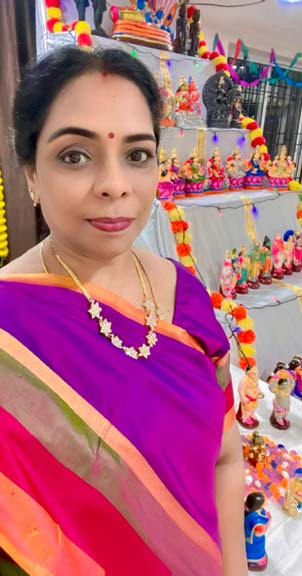
DEVI NAVRATRI, the nine days of prayers to MAA DURGA precedes DUSSHERA, one of the most popular festivals among the hindu festivals, celebrated all across the country with immense devotion, in the honour of goddess DURGA, NAVRATRI literally means nine nights ; it is the festival of nine auspicious days and nine auspicious nights dedicated to ETERNAL MOTHER GODDESS DURGA ; MAA DURGA is worshipped in nine different forms and each day is dedicated to nine different manifestation of MAA DURGA; DURGA PUJA is worshipping each incarnation of the SUPREME POWER, which commemorates the victory of MAA DURGA over the powerful demon king MAHISHASUR, she assumes different forms to protect and uplift her devotees.
In different parts of INDIA there is varied beliefs and stories regarding NAVRATRI, according to a story in the Hindu Mythology, which is widely believed, a buffalo headed demon king MAHISHASUR, undertook a rigid penance, to please LORD SHIVA, to attain eternity, and when nothing could distract or prevent him from the rigorous devotion, LORD SHIVA feared absolute destruction, to the entire creation, which would be the consequence of the austerity, if uninterrupted, and also pleased with the devotion, immediately appeared in front of MAHISHASUR, on sighting LORD SHIVA, MAHISHASUR was mighty pleased and seeked a boon of eternity for himself and also with a condition that he should never be defeated by human, god/devas or demons/asuras and would only attain mortality, by his mother or a feminine form. and SHIVA left with no option had to grant him the boon,( another belief is that AGNI/FIRE GOD granted the boon to MAHISHASUR ), armed with infinite power, and newly gained confidence, he wished to conquer the heavens, by dethroning LORD INDRA, the god of gods, and become the undisputed emperor of the entire universe. HE was symbolic of ignorance, hence was blatantly misusing the power and imposing a tyrant rule, thus terrorising one and all. LORD INDRA, along with all the gods approached the HOLY TRINITY (BRAHMA, VISHNU, SHIVA), for a solution, and with their help and the other devas declared and waged a war against MAHISHASURA, but in vain, as none could defeat him because of the boon granted to the demon king, no man could kill him, hence to protect the world from the atrocities of MAHISHASURA, LORD VISHNU after weighing all the possibilities, arrived at a conclusion that a supreme feminine power had to be created to eradicate MAHISHASURA, so the trinity united their powers and formed a divine female power, who was known as MAA DURGA, to free the world from the atrocities of the demon.
When MAHISHASUR, saw her was mesmerised and empowered by the divine and dazzling beauty of the GODDESS, and approached her with a marriage proposal, She agreed to his proposal with the condition, that he had to fight a battle and win her over in the battle and the over-confident demon king agreed immediately and the fierceful battle started and continued for nine days, each day, MAA DURGA, attained a new form, to fight the evil king and proved to be a tough competitor, due to the boon, when Goddess SH AKTI beheaded the demon MAHISHASUR; in her Eight-armed form with supreme weapons, riding an equally powerful lion, gave an equally tough battle and, finally extremely outraged, she attained the form of MAA KALI or CHANDIKA and as she beheaded the demon, he was assuming the form of a buffalo and was doing the vanishing act, then later in the battle she overpowered and threw him on the ground, she stood on his chest and beheaded him with a trishulam. She could have reduced the demon to ashes, with her eyes, by merely looking/glaring at him, but she wanted to touch him with the supreme weapons to purify him, the message was eradicate the sin and not the sinner, so she chose to engage in a battle, with MAHISHASUR. MAA DURGA slained the evil demon king and emerged victorious and freeing the entire universe from the menace/ MAHISHASUR, and then onwards, was known as MAHISHASUR-MARDINI, ensuring protective and peaceful world; as freedom was obtained on the ninth night, the tenth day was known as VIJAYA DASHAMI, as MAA DURGA gained victory by empowering and killing MAHISHASUR. and ever since then NAVRATRI is observed by performing pujas and the 10TH day is celebrated as DUSSHERA/VIJAYADASAMI ; A TRIUMPH OF GOOD PREVAILING OVER THE EVIL, it is strongly believed by hindu community that the NAVRATRI puja marks the eradication of enemies and evil/troubles / and paves new way to success.
According to hindu calendar, in the lunar month of ASHWINA/ ASHWAYUJAM, the first day or the Pratipada of the fortnight marks the commencement of the first day of NAVRATRI and it is called the SHARAD NAVRATRI as it starts in the beginning of winter( mid SEP to mid OCT, as per the Gregorian calendar), as there are RAAM-NAVRATRI / GUPT NAVRATRI/ PAUSHYA NAVRATRI ,but since this is the most significant of them all , it came to be known as MAHA NAVRATRI.
The form of worship may vary in each state in INDIA, yet these auspicious nine days are celebrated with utmost devotion and entirely dedicated to worship MAA DURGA and invoke her blessings.
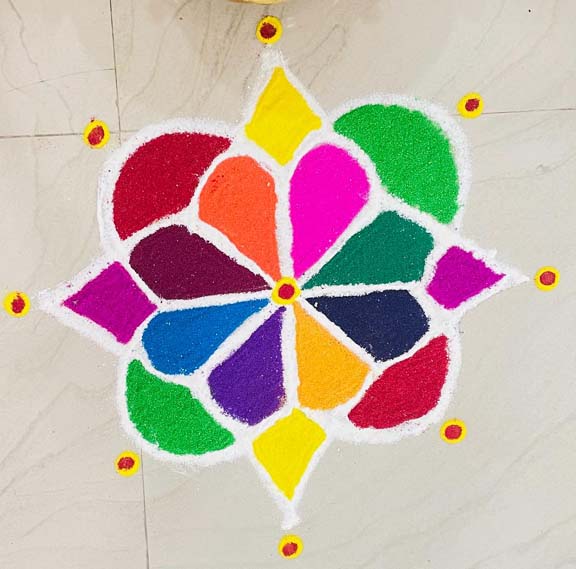
On the first day, MAA is welcomed with KALASH STHAPANA, i.e., installing a brass pot filled with water smeared with turmeric and decorated with spots of vermillion, a coconut, wrapped with strands of mango leaves is placed in the brass pot and is decorated with silk piece of cloth and face of goddess is placed and is worshipped for nine days and later floated in water bodies.
Barley seeds are placed in small mud beds in pots near the Goddess, and watered ,2nd / 3rd day they start sprouting and grow into plants.on the 10th day the shoots are about 3 to 6 inches in length, later they are pulled out and given to devotees as blessings for prosperity, when this method is practiced at home, It is believed that this growth indicates the progress and growth of the devotees sowing the seeds.
The 1st, 2nd and 3rd days are dedicated to DURGA MAA, the Goddess of power of energy, she is worshipped in the form of BALPARMESHWARI/KUMARI, PARVATI, and KALI, each form representing the child, the young girl and the mature woman respectively;
The 3rd, 4th & 5th days, MAA is worshipped in the form of MAA LAKSHMI, Goddess of fortune and wealth .
The 5th day is known as LALITH PANCHAMI, traditionally all The available literature available at home are displayed and lamp lighted and prayers are offered to MAA SARASWATI.
The 6th 7th, & 8th days, MAA is worshipped as MAA SARASWATI Goddess of WISDOM, KNOWLEDGE and ART to seek her blessings.
8th DAY is celebrated as DURGAASHTAMI, and SARASWATI PUJA is performed, temples conduct AKSHARABYAASAM, for toddlers, to mark their commencement of Education. Parents have to guide the child to inscribe the sacred alphabet OM. In a plate spread with rice, either with a coin or a flower.
Books, pens and other literary accessories are placed in the SARASWATI PUJA and distributed among the children/students, Both in temples and after puja at home.
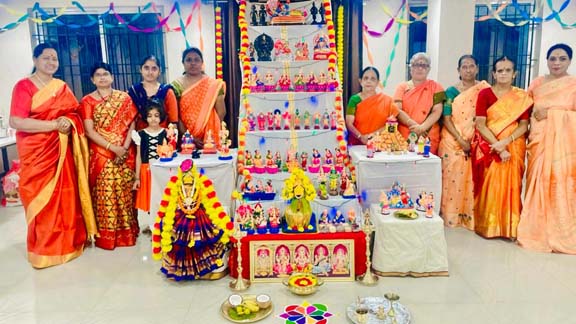
9th day is MAHA NAVAMI, is also worshipped as AYUDHA PUJA, after MAA DURGA, eradicated MAHISHASURA, she collected all the supreme weapons used in the battle, performed puja to the weapons, as the aided her in and kept it aside, as they finished serving the purpose, hence, AYUDHA PUJA is observed, to all machinery, automobiles, to ensure smooth functioning, and safety for the rest of the year.
KANYA PUJA is performed on MAHAA NAVAMI, 9 girls, below their teens are invited and worshipped as the 9 forms of MAA DURGA. Their feet are washed and sweets, gifts are offered.
The 10th day DASHAMI, concludes NAVRATRI, it is dasera, the word DASERA is derived from a Sanskrit word dasa + hara =REMOVER OF BAD FATE, or rejoicing the triumph of Good over evil.
The 9 forms of DURGA MAA, worsipped during each day of NAVRATRI is broadly explained as follows:
On the 1st day, DURGA, is worshipped as MAA SHAILPUTRI, meaning daughter of a mountain, as she took birth as the daughter of PARVATRAJ she was known as shailputri, she is mounted on a bull, she holds a lance in her right hand and a lotus in her left hand.
On second day she is worshipped as MAABRAMHACHARINI
Brahma means meditation or tapasya, when she was born as shalputri, she meditated over thousand years under the guidelines of Devrishi NARAD, to obtain SHIVA as her husband.
Third day is dedicated to MAA CHANDRAGHANTAA, as she is adorned by a crescent moon and shaped like a bell;
CHANDRA means MOON and GHANTA, a bell. In this form, she eradicates evil doers and enemies and ensures protection from dangers.
MAA DURGA's fourth form is MAA KUSHMANDA, SHE provides, basic necessities and is aadi shakti and is the creator of whole Universe.
Fifth day, MAA is worshipped as SKAND MATHA, meaning Mother of SKANDA/KARTIKEYA/(PARVATI's second son, 1st being Ganesha. and is seated on the lotus and provides all with bounties of all kinds.
Sixth form of MAA DURGA is KATYAYINI, when a sage called KAATYAYAN performed a very rigorous penance to MAA DURGA, and expressed a wish that he wanted to have MAA DURGA as his daughter, when the trinity contributed their powers in union to form the DIVINE POWER/ MAA SHAKTI, to slain MAHISHASUR, she named herself as KAATYAYINI, as the MAHARISHI wished to have her as his daughter.
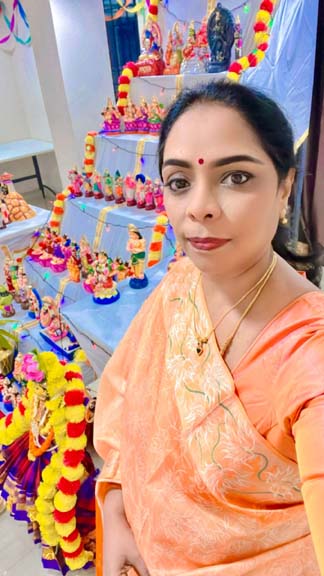
The seventh form of MAA is worshipped as MAA KAALRATRI also known as MAHA KAALI or KALI Avtar as she killed RAKTA BEEJA, demon who produced a new demon out of the blood droplet that fell on the ground, finally, she fastened the fallen heads in a rope and wore it as a garland around her neck, and not letting the blood fall on the ground she licked it and slained the demon.
On the eighth day she is worshipped as MAHAA GAURI, dressed in white, she is the softest form of MAA DURGA.
The ninth form is SIDDHDATRI, a treasure of mystic powers and also knowledge. she is worshipped by all.
Tenth day/ VIJAYADASHAMI/ DASERA, MAA DURGA is worshipped to protect us from evil and grant us success,
At Temples, institutions and homes, events are organized to celebrate NAVRATRI with puja and Entertainment programmes, such as GARBA a dance in circular motion by devotees around a divine lamp or a statue of DURGA MAA, DANDIA nights form a major part of the NAVRATRI CELEBRATIONS. Dandia is a dance form played in two circles, of players one circle moving clock wise and the second round moving anti clock wise, with, two dandia sticks, moving them rythmatically in tandem with the folk-lore. The women attire themselves with colourful CHANIYA-CHOLI, and men folk wear KEDIA, high waist tops, which swirl round while dancing.
According to a legend, BATHKAMMA/ PARVATI, was a lover of flowers so down South, BATHKAMMMA a spring festival, of nine days also known as BODEMMA is observed, in her honour, which coincides with NAVRATRI or on the day before NAVRATRI begins, it ends on DURGASHTAMI, it falls in the month of SEP-OCT/ASHWAYUJA ; BATHKAMMA is an arrangement of flowers in concentric circles around a water pot ; the pot is adorned with seasonal flowers, of odd numbers, either 3, 5, 7 types of different flowers are collected and strewn into strands and are stacked around the pot in circles which tapers as it reaches the top of the pot to take a conical shape or the form of gopuram, a lump of turmeric is placed on the top of the pot and this denotes the goddess DURGA. Each lady prepares her own BATHKAMMA and on the eve of NAVRATRI, all the women-folk, gather and place their BATHKAMMA in the middle and form a circle around it and dance, moving to and fro, clapping their hands in union,
Later on DURGASHTAMI, after a puja to the BATHKAMMA, MALLEEDA a prashad prepared with jaggery is distributed among the devotees and each bathkamma is floated in a lake, river or sea which is known as BATHKAMMA NIMMARJANAM, the immersion of goddess, offering a lovely sight and this concludes the festival.
In most places beautiful statues of MAA DURGA are installed, in pandals and programmes organized for the NAVRATRI and later immersed on DASHAMI, in water bodies.
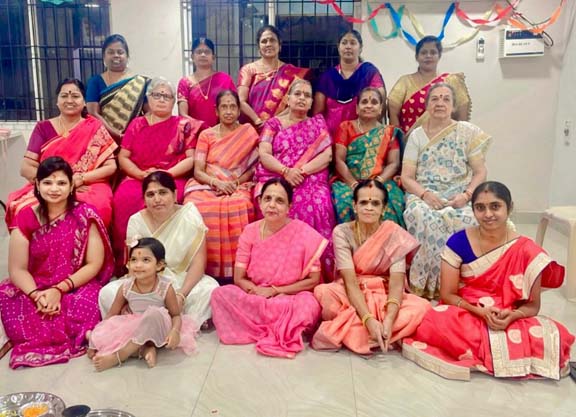
In some parts of South, the traditional BOMMA KOLLU /GOLU or BOMMALA KOLUVU, is observed during NAVRATRI. It is an artistic display of dolls arranged in odd numbered stairs, maximum number is nine levels representing nine days, but the number of steps are determined by the individuals / women-folk in their homes in accordance with the availability of dolls; this arrangement represents the assembly of MAA DURGA, which was held just before she left to slay MAHISHASUR., hence the tradition followed.it is also believed that, all the gods and goddesses transferred their powers to MAA DURGA to aid her to fight the demon king,
MAHISHASUR, and they stood still, as they were powerless, To pay respect to this self sacrifice of deities, hindus revere Toys and dolls in the shape of gods and goddesses'
There is no hard and fast rule in the arrangement of dolls but If tradition had to be followed then
The first 3 steps are dedicated to gods and goddesses, colourful idols, statues either hand made or ready made are arranged along with the main purna KUMBHAM/KALASHAM, which denotes the Goddess, the collection increases with annual addition of dolls and idols, thus making the arrangement more elaborate.
4,5 and 6 levels are for RELIGIOUS PERSONALITIES AND highly respected leaders of the country,
7th step is dedicated to social activities, festivals, marriage, bride/groom.
8th step is the interesting step as it represents creative art like a market place/ a park and a variety of crafts/it has the personal skill of the lady of the house.
The last and the 9th step is arranged with clay or wooden Dolls of men/women/children, birds and animals.
All the sumangalis / neighbours, friends and relatives are invited and pujas held in union, devotional songs are sung in praise of the goddess DURGA, THAMBULAM is offered, SWEETS AND CHANNA preparation known as SUNDAL in the form of prashad is distributed; gifts are given away in the form of blouse pieces and kumkum bharanis ; children also form a part of kolu, they enjoy the display of dolls , the celebration and are offered some Dolls, toys, fruits, books, as gifts.
Kollus are good occasions to socialize and also exhibit talent and also the display, helping in bonding of people.
In some parts DASHAMI THE TENTH DAY is also celebrated in honour of lord RAMA. It is believed that people rejoiced this day as DUSSHERA, as LORD RAMA returned to AYODHYA, after killing the ten headed RAVAN, and releasing SITA MAA.
RAM LEELA is held, in various states; it is re-enacting the mythological epic/RAMAYAN, in open auditoriums, during the NAVRATRI season, and on the 10thday/DASHAMI, huge effigies of RAVAN, MEGHNATH and KUMBKARAN are placed in open areas and are set ablaze, thus letting the evil be burnt to ashes, concluding the event.
The subject of MAA DURGA is vast and there are countless anecdotes depicting MAA, her tasks, penance, success, worship.
A little devotion is needed to get enlightened about MAA DURGA, though we all may have different beliefs about the legends and differ in the form of worship and celebration, the fact remains that the entire country unites and remains totally dedicated to MAA DURGA, irrespective of age, caste and creed, one and all are engrossed in NAVRATRI puja and celebrations,
The next day after DUSSHERA, people pray to the AAPTA TREE/JAMBI and visit each other and exchange these jambi leaves also known as golden leaves as symbol of gold and wish each other a bright and prosperous future, known as JAMBI MULAKAT/ MEETING.
THIS CONCLUDES THE TEN DAYS FESTIVE BONANZA.
JAI MATA DI!!